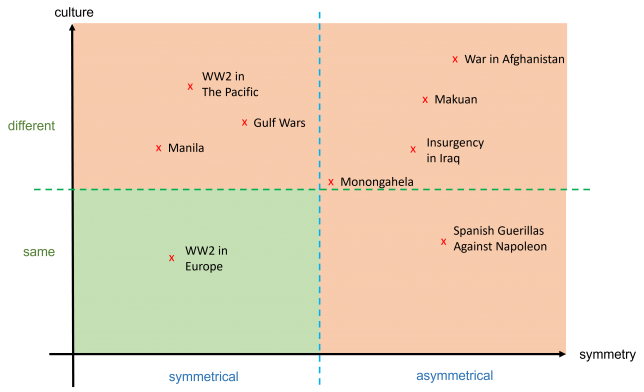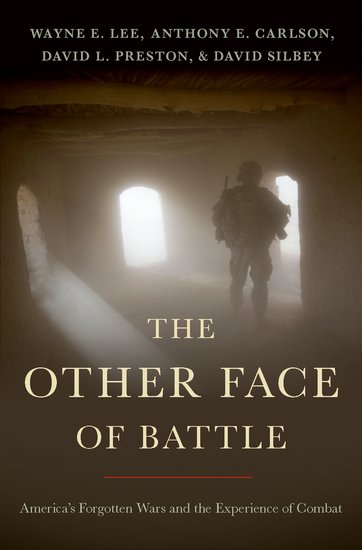(Full Disclosure: Oxford University Press provided me with a review copy of The Other Face of Battle in Ebook format)
For historical sciences, the cultural turn in social sciences signified the final stage of a development that had started with political history, in German often derided as Ereignisgeschichte (history of events), had led to structural history and finally culminated in Kulturgeschichte, the history of cultures. Whereas political history is often concerned with great persons (often men), significant events (hence the derisive name) and states as amorphous but very much alive actors in history, structural history is about structures, their historical development and how they influenced others. Culture, in contrast to structures or events, came into the focus of historic study with the development of cultural history after the cultural turn in the 1980s. With this came a redefinition of the word culture: away from the high culture of elites, which meant theater and the arts, towards culture as a basic framework of human interaction. In the spirit of ethnologist Clifford Geertz’s, who famously said: “man is an animal suspended in webs of significance he himself has spun” (in his work Thick Description. Toward an Interpretative Theory of Culture, in: ders., The Interpretation of Cultures, New York 1973, S. 3–30, hier S. 5.). One of the most significant publications that accompanied this process was The New Cultural History edited by Lynn Hunt. It was one of the first widespread efforts to look beyond the boundaries of scientific disciplines and combine different perspectives from sociology, history, ethnology or anthropology.
Military history went through a similar development, albeit not always in synch with the other social sciences. There is this cliché that military history is done by amateurs, and there is some truth to it. Much of military history is driven by those who put an undue focus on battles, colorful flags, badges, medals and commanders. This changed with John Keegan’s 1976 book The Face of Battle, one of the most significant works in military history, that catapulted military history right into the new cultural turn. Annoyed by the mechanistic description of battles, devoid of detail, rife with myths and prejudice, Keegan set out to chronicle the details of the experience of the soldier on the ground, face to face with the enemy. Keegan took three significant battles of British history, Agincourt, Waterloo, and the Somme, and examined them from the soldiers’ perspective. In doing so, he could show that many of the myths in military history were just that, myths. For example, one such myth is the effectiveness of medieval cavalry, which was by far not as dominant as is often assumed. The dominance of the cavalry was more a side effect of the dominance of the aristocratic class that made it up, showing again the influence of perception and cultural bias in warfare, a fact that is well demonstrated in Wayne E. Lee’s earlier works (in this case specifically Waging War).
The Face of Battle was a first step in this direction, The Other Face of Battle by Wayne E. Lee, Anthony E. Carlson, David L. Preston and David Silbey is the next. The goal remains similar: to show the personal experience of combat, but to do so particularly across cultural boundaries. Whereas Keegan looked at battles between very similar armies and culturally similar opponents, The Other Face of Battle focuses on battles that have a significant factor of asymmetry and cultural alienation. The authors define symmetrical warfare as warfare in which “[…] belligerents have the same general goals, organize and equip their forces in similar ways and operate through similar strategies and according to similar rules of engagement and standards of acceptable conduct.” Asymmetrical conflict is conflict where one side is trained, equipped and fielded by a government, and the other side is not. They use a framework of two factors, culture and symmetry, with two attributes, symmetrical and asymmetrical, as well as similar and different culture, respectively.

Following Keegan’s example, the authors looked at three iconic battles of US history: Monongahela 1755, Manila 1899, and Makuan 2010. The defining characteristic in each of these battles is that US forces fought an enemy that was either asymmetrical, had a different culture, or both. In Monongahela, US troops, as part of a British expedition (before American independence), faced off against Amerindians who fought with the French for hegemony over the Colonies. British and Colonial troops lost the battle because they were thoroughly unfamiliar with the Amerindian fighting style and were lured into territory in which their Amerindian enemies could bring their tactics to full effect. In Manila, the US had just defeated the Spanish and took further steps in creating a global empire, alienating the native Filipinos who were hoping to receive their independence from the US. Americans and Filipinos fought a conventional battle which the Filipinos lost. However, Filipino rebels quickly transitioned into an insurgency and would harass US troops for years to come. In Makuan, US troops faced Afghan insurgents who would use tactics to avoid American strengths in firepower and still inflict casualties on US troops via IEDs and ambushes. US troops were thoroughly alienated by their enemies in all three battles. What is amazing is that after each war the US turned around and prepared for a conventional war that was nothing like the one it had just fought, even though the evidence was clear that it was more likely to fight an unconventional war with an enemy with a different culture, instead of a peer-to-peer conflict. We see this development again today, as US forces, and many of their Western allies like Germany, transition to large scale combat operations (LSCO), even though it is more than likely that the future ahead will be more asymmetrical and inter-cultural.
Key questions that The Other Face of Battle clarifies but does not (could any book, anyway?) answer, are: When, really, is a battle won or lost? When to different forces give or deny battle? What are the cultural paradigms that govern conflict? Ultimately, victory and defeat are to a great part decided in the mind, and different cultures have different understandings for both.
By showing how clashes of forces from different cultures impact soldiers and militaries, the authors make an important contribution to the quest of better understanding human conflict. The Other Face of Battle ties in very well with earlier works from the authors; for example Waging War by Wayne E. Lee, or Empire and Indigenes as well as Warfare and World History, both edited by Wayne E. Lee. It is a good complement to other works that try to explain the origins and character of human conflict, like Azar Gat’s War in Human Civilization or evenEvolutionary Psychology by David M. Buss, which looks at war and conflict through the lense of evolution and psychology.
The Other Face of Battle is a fascinating and interesting book that should be read by defense professionals.
What did you think of The Other Face of Battle? Share your thoughts in the comments!
